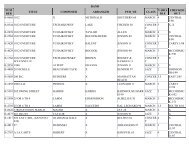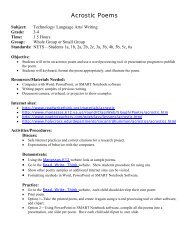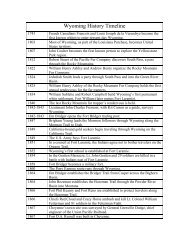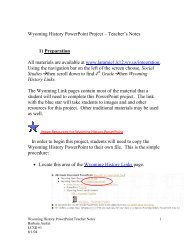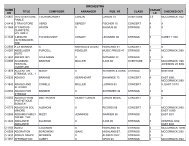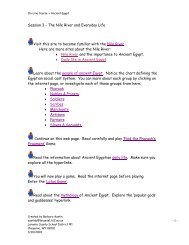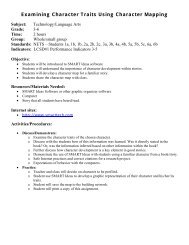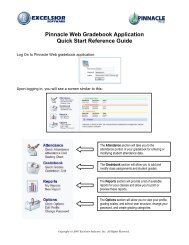You also want an ePaper? Increase the reach of your titles
YUMPU automatically turns print PDFs into web optimized ePapers that Google loves.
<strong>Drug</strong> <strong>Awareness</strong> <strong>WebQuest</strong><br />
Alarming Smoking Statistics and Related Activities<br />
1. Each year in the United States, smoking related illnesses kill 440,000<br />
people. 140,000 of these people die from lung cancer alone. If these<br />
statistics remain constant over the next 20 years, how many people will die<br />
from smoking<br />
Use the calculator on the computer and find the answer and write the answer<br />
in the space provided below.<br />
Lung Cancer-<br />
Smoking related illnesses-<br />
2. Cigarettes cost approximately $3.16 per pack. If a person smokes two<br />
packs a day, how much will they spend on cigarettes in a year<br />
(year=365 days)<br />
Use this number to figure out how much they will spend over the course of a<br />
lifetime. When figuring out lifetime cost, assume the smoker smokes for 50<br />
years.<br />
Yearly cost of smoking<br />
Lifetime cost of smoking<br />
3. Nicotine, alcohol, cocaine, marijuana, and ecstasy are the most readily<br />
available drugs throughout the country, as well in Wyoming. Each one of<br />
them negatively affects the nervous system. Using this link, investigate<br />
three drugs and their effect on the nervous system. Using Word create a<br />
mini-table with this information. Make sure your name is on your table,<br />
print it and attach it to your worksheets.<br />
March 9, 2006<br />
<strong>Drug</strong> <strong>WebQuest</strong><br />
Page 1 of 6
4. Match the Question with the appropriate Web resource(s).<br />
Questions<br />
1. John has a friend who has had<br />
difficulty with drinking. One night,<br />
John’s friend has a problem and<br />
needs help. Where can John call to<br />
get him help<br />
2. Bill has a father who is an<br />
alcoholic. Where can Bill go for<br />
support<br />
3. Sally had a problem with alcohol<br />
and wants to find a support group to<br />
attend. What group could Sally join<br />
4. Rachel does not know much<br />
about tobacco use, but would like to<br />
be educated on this topic. Which<br />
website will help her<br />
5. Evan is under 18 and uses tobacco<br />
but doesn’t know the laws about it.<br />
Where should he go to learn more<br />
6. Molly is addicted to drugs and her<br />
family needs to send her to a<br />
recovery center. Which organization<br />
should her family look into<br />
7. What organization fights drug<br />
addictions by providing the public<br />
with information<br />
8. Which organization focuses on<br />
young adults to prevent illicit drug<br />
use<br />
9. One of Mark’s friends has<br />
mentioned suicide, which site lists<br />
suicide prevention as a service<br />
Web Site Resource Links<br />
a. http://www.bernielorenzrecovery.org/<br />
b. http://www.aa-iowa.org/<br />
c. http://www.f2online.org/<br />
d. http://www.area76wyaa.org/<br />
e. http://idph.state.ia.us/tobacco/quitline<br />
f. http://www.mediacampaign.org/<br />
g. http://www.tobaccofreepartnership.com<br />
h. http://www.freeandtrue.com/<br />
i.<br />
http://www.4therapy.com/centers/wyomingdrug-rehab.html<br />
j. http://www.drugs-addiction.org/<br />
k. http://wdh.state.wy.us/main/search.asp<br />
l. http://www.whrn.org/quit_tobacco.htm<br />
March 9, 2006<br />
<strong>Drug</strong> <strong>WebQuest</strong><br />
Page 2 of 6
10. Suzie’s parents are looking for a<br />
support group dealing with teen drug<br />
problems Which site would help<br />
11. Jack’s parents found marijuana in<br />
his backpack. What site has<br />
information about marijuana<br />
m. http://www.al-anon.alateen.org/<br />
n. http://www.ncadd.org/index.html<br />
Brain Map Activity<br />
<strong>Drug</strong>s and alcohol affect different parts of a person's brain in different ways.<br />
The brain is divided into different sections, or lobes, each of which perform<br />
different functions. Below is a list of the basic functions of each lobe.<br />
Frontal:<br />
short-term storage site<br />
controls voluntary movement<br />
transforms thoughts into words<br />
goal-directed behavior, concentration<br />
emotional control and temperament --aggression<br />
motor projection and association areas<br />
coordinate messages from other lobes<br />
problem-solving<br />
Parietal:<br />
receive information about temperature, taste,<br />
touch, and movement from the rest of the body<br />
controls reading<br />
controls arithmetic<br />
sensory projection and association areas<br />
visual/spatial abilities<br />
http://library.thinkquest.org/11799/data/brain2.html<br />
Occipital:<br />
processes images from the eye<br />
links information from images to images in memory<br />
receives and processes visual information<br />
March 9, 2006<br />
<strong>Drug</strong> <strong>WebQuest</strong><br />
Page 3 of 6
Temporal:<br />
receives information from the ears<br />
forms and retrieves memories, including musical memories<br />
integrates memories and senses, like taste, touch, sight, and sound<br />
complex vision<br />
balance and equilibrium<br />
emotions and motivations<br />
some language comprehension<br />
Cerebellum:<br />
controls body's vital functions, like respiration and heart rate<br />
coordinates movement in learned rote movements, reflexes (e.g., balance)<br />
5. Next, your task is to complete the chart below, filling in the missing<br />
information. Some information may be true to several drugs. Some of the<br />
drugs and lobes will be used more than once. Fill in the <strong>Drug</strong> Effects<br />
column with the effect that matches the drug and the lobe that is affected by<br />
the drug.<br />
Use these links for this activity:<br />
NIDA for Teens Facts on <strong>Drug</strong>s- Brain & Addiction<br />
Brain Basics – Know Your Brain<br />
Brain on <strong>Drug</strong>s<br />
A Guide to the <strong>Drug</strong>s and the Brain<br />
March 9, 2006<br />
<strong>Drug</strong> <strong>WebQuest</strong><br />
Page 4 of 6
Alcohol Tobacco Marijuana Cocaine Methamphetamine<br />
Frontal Temporal Parietal Occipital Cerebellum<br />
Substance: <strong>Drug</strong> Effects: Lobe affected by<br />
<strong>Drug</strong>s:<br />
1. impaired balance and<br />
Frontal<br />
coordination<br />
2. Marijuana Temporal<br />
3. Methamphetamine aggression, violence<br />
4. Cocaine Parietal<br />
5. Tobacco irritability due to addiction Parietal<br />
6. Alcohol slowed thinking and reaction<br />
time<br />
7. Chest pain, respiratory failure Cerebellum<br />
8. Marijuana Increased heart rate, anxiety<br />
9. Tobacco impaired sense of taste and smell<br />
10. Methamphetamine Occipital<br />
6. Create a digital poster for "Students Against <strong>Drug</strong> Abuse". Use<br />
information you have gained on this <strong>WebQuest</strong> and come up with a ‘catchy’<br />
slogan. Create your poster using, Word, PowerPoint, or Publisher.<br />
7. See the Video Clip at <strong>Drug</strong> Free Wave.<br />
8. First of all, play Sara’s Quest. Sara's Quest has been developed for use in<br />
schools or in the home for children to learn about the effects of drugs on<br />
their brain and body. If you choose continue in this web site and try Space<br />
Wrangler Game, Dr. Nida’s Challenge. Or the HIV, Aids and <strong>Drug</strong> Abuse<br />
Game.<br />
March 9, 2006<br />
<strong>Drug</strong> <strong>WebQuest</strong><br />
Page 5 of 6
Resources:<br />
• NIDA for Teens Facts on <strong>Drug</strong>s- Brain & Addiction<br />
• Brain Basics – Know Your Brain<br />
• Brain on <strong>Drug</strong>s<br />
• A Guide to the <strong>Drug</strong>s and the Brain<br />
• <strong>Drug</strong> Free Wave<br />
• http://staff.washington.edu/chudler/introb.html#drug<br />
• http://www.uni.edu/schneidj/webquests/fall04/drugs/process.html<br />
• http://academics.uww.edu/cni/webquest/Fall02/AODA/Index.htm<br />
Wyoming State Health Standards Addressed in this project:<br />
4840. Access Health Information, Products, and Services<br />
Students demonstrate the ability to access valid health<br />
information and health-promoting products and services.<br />
4841. Self Management<br />
Students demonstrate the ability to practice health-enhancing<br />
behaviors and reduce health risks.<br />
4842. Influence of Culture, Media and Technology<br />
Students analyze the influence of culture, media, technology,<br />
and other factors on health.<br />
4844. Goal-Setting and Decision-Making Skills<br />
Students demonstrate the ability to use goal-setting and<br />
decision-making skills to enhance health.<br />
4845. Advocating for Health<br />
Students demonstrate the ability to advocate for personal,<br />
family, and community health.<br />
March 9, 2006<br />
<strong>Drug</strong> <strong>WebQuest</strong><br />
Page 6 of 6



